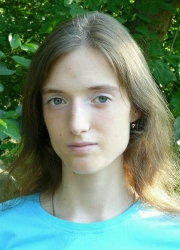Viktoriia Kornich
ContactDepartment of PhysicsUniversity of Basel Klingelbergstrasse 82 CH-4056 Basel, Switzerland
|

|
CV
July 2012 - March 2016 PhD student in the Condensed Matter Theory group of the University of Basel, under the supervision of Prof. Dr. D. Loss.2010-2012 Master studies at the Moscow Institute of Physics and Technology, Department of Physical and Quantum Electronics. Master thesis at the Kotelnikov Institute of Radio Engineering and Electronics of the Russian Academy of Science.
2006-2010 Bachelor studies at the Moscow Institute of Physics and Technology, Department of Physical and Quantum Electronics. Bachelor thesis at the Kotelnikov Institute of Radio Engineering and Electronics of the Russian Academy of Science.
Publications
Show all abstracts.| 1. | Phonon-assisted relaxation and decoherence of singlet-triplet qubits in Si/SiGe quantum dots |
| Viktoriia Kornich, Christoph Kloeffel, and Daniel Loss. arXiv:1511.07369
We study theoretically the phonon-induced relaxation and decoherence of spin states of two electrons in a lateral double quantum dot in a SiGe/Si/SiGe heterostructure. We consider two types of singlet-triplet spin qubits and calculate their relaxation and the decoherence times, in particular as a function of level hybridization, temperature, magnetic field, spin orbit interaction, and detuning between the quantum dots, using Bloch-Redfield theory. We show that the magnetic field gradient, which is usually applied to operate the spin qubit, may suppress the relaxation time by more than an order of magnitude. Using this insight, we identify an optimal regime where the magnetic field gradient does not affect the relaxation time significantly, and we propose regimes of longest decay times. We take into account the effects of one-phonon and two-phonon processes and suggest how our theory can be tested experimentally. The spin lifetimes we find here for Si-based quantum dots are significantly longer than the ones reported for their GaAs counterparts.
| |
| 2. | Voltage induced conversion of helical to uniform nuclear spin polarization in a quantum wire |
| Viktoriia Kornich, Peter Stano, Alexander A. Zyuzin, and Daniel Loss. Phys. Rev. B 91, 195423 (2015); arXiv:1503.06950.
We study the effect of bias voltage on the nuclear spin polarization of a ballistic wire, which contains electrons and nuclei interacting via hyperfine interaction. In equilibrium, the localized nuclear spins are helically polarized due to the electron-mediated Ruderman-Kittel-Kasuya-Yosida (RKKY) interaction. Focusing here on non-equilibrium, we find that an applied bias voltage induces a uniform polarization, from both helically polarized and unpolarized spins available for spin flips. Once a macroscopic uniform polarization in the nuclei is established, the nuclear spin helix rotates with frequency proportional to the uniform polarization. The uniform nuclear spin polarization monotonically increases as a function of both voltage and temperature, reflecting a thermal activation behavior. Our predictions offer specific ways to test experimentally the presence of a nuclear spin helix polarization in semiconducting quantum wires.
| |
| 3. | Nuclear Spin Relaxation in Rashba Nanowires |
| Alexander A. Zyuzin, Tobias Meng, Viktoriia Kornich, and Daniel Loss. Phys. Rev. B 90, 195125 (2014); arXiv:1407.2582
We study the nuclear spin relaxation in a ballistic nanowire with hyperfine and Rashba spin-orbit interactions (SOI) and in the presence of magnetic field and electron interactions. The relaxation rate shows pronounced peaks as function of magnetic field and chemical potential due to van Hove singularities in the Rashba bands. As a result, the regimes of weak and strong SOIs can be distinguished by the number of peaks in the rate. The relaxation rate increases with increasing magnetic field if both Rashba subbands are occupied, whereas it decreases if only the lowest one is occupied.
| |
| 4. | Phonon-Mediated Decay of Singlet-Triplet Qubits in Double Quantum Dots |
| Viktoriia Kornich, Christoph Kloeffel, and Daniel Loss. Phys. Rev. B 89, 085410 (2014); arXiv:1311.2197
We study theoretically the phonon-induced relaxation (T_1) and decoherence times (T_2) of singlet-triplet qubits in lateral GaAs double quantum dots (DQDs). When the DQD is biased, Pauli exclusion enables strong dephasing via two-phonon processes. This mechanism requires neither hyperfine nor spin-orbit interaction and yields T_2≪T_1, in contrast to previous calculations of phonon-limited lifetimes. When the DQD is unbiased, we find T_2≃2T_1 and much longer lifetimes than in the biased DQD. For typical setups, the decoherence and relaxation rates due to one-phonon processes are proportional to the temperature T, whereas the rates due to two-phonon processes reveal a transition from T_2 to higher powers as T is decreased. Remarkably, both T_1 and T_2 exhibit a maximum when the external magnetic field is applied along a certain axis within the plane of the two-dimensional electron gas. We compare our results with recent experiments and analyze the dependence of T_1 and T_2 on system properties such as the detuning, the spin-orbit parameters, the hyperfine coupling, and the orientation of the DQD and the applied magnetic field with respect to the main crystallographic axes.
|
